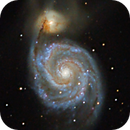I'm getting my kicks by processing my images using my own Python programs. Not talking about processing skills, this means that the end results may not be as good as they could be if processed with better tools. I am thus very interested in seeing what can be obtained from one of my stacks with, e.g., PixInsight or Astropixel Processor (or any other state of the art S/W). I could try that myself but I don't know either one and would not know how to best use them. This stack:
https://www.dropbox.com/s/u7wazbbbxg3hl5m/M51_astrobin.fts?dl=0
is the source for this M51:

I call it atypical because it was obtained with a Samyang 135. So not the best image of M51, but I'm playing with getting the most out of a little lens.
My version of the stack was obtained by wavelet regularized Richardson-Lucy deconvolution followed by luminance stretch, saturation and two passes of unsharp mask. For the deconvolution, I did the RGB channels separately (with PSF estimated from stars) and ran 50 iterations on the red channel and 20 on the other two. My deconvolution is a bit heavy and I do have some ringing around the stars. I'm sure there is room for improvement.
So if anybody has time to spare (hum), I'm very curious to see what is possible. Feel free to use the fits anyway you like!
CS
Frédéric
https://www.dropbox.com/s/u7wazbbbxg3hl5m/M51_astrobin.fts?dl=0
is the source for this M51:

I call it atypical because it was obtained with a Samyang 135. So not the best image of M51, but I'm playing with getting the most out of a little lens.
My version of the stack was obtained by wavelet regularized Richardson-Lucy deconvolution followed by luminance stretch, saturation and two passes of unsharp mask. For the deconvolution, I did the RGB channels separately (with PSF estimated from stars) and ran 50 iterations on the red channel and 20 on the other two. My deconvolution is a bit heavy and I do have some ringing around the stars. I'm sure there is room for improvement.
So if anybody has time to spare (hum), I'm very curious to see what is possible. Feel free to use the fits anyway you like!
CS
Frédéric

